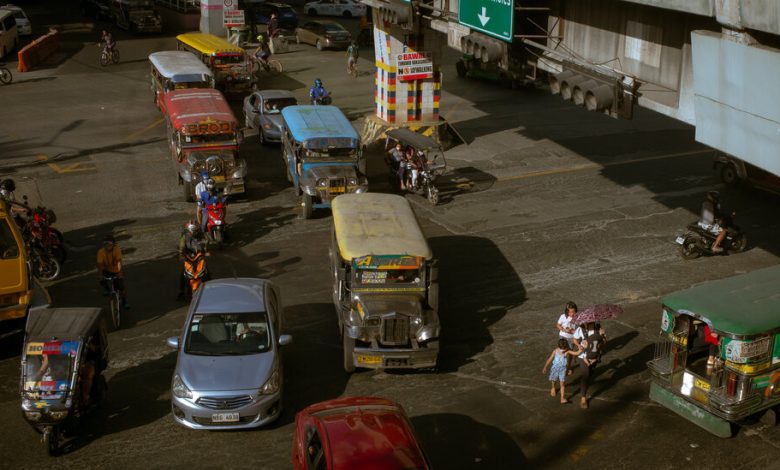Colorful, Iconic Jeepneys May Soon Be Off the Road in the Philippines

MANILA — In the Philippines, they are known as “kings of the road,” colorful, open-air vehicles with loud horns and diesel engines that ferry millions of Filipinos on their daily commutes. Called “jeepneys” for their origins as U.S. military jeeps, they are cramped and stiflingly hot, ubiquitous on the busy city streets where many riders consider them an icon.
The government wants the iconic rides off the road.
Jeepneys nationwide were scheduled to be phased out by the end of the year, to be replaced by more expensive minibuses under a government modernization program. At a price of $43,600, the new replacement vehicles are more energy-efficient, comfortable and safe. But many jeepney drivers say they can’t afford them, and not having a vehicle would mean the end of their livelihood.
They also dislike the program’s approach to helping them afford the minibuses. The plan would require jeepney drivers to form a cooperative to be able to borrow funds from government banks to purchase the new vehicles. These transport cooperatives would then operate on a profit-sharing scheme, a model that drivers say will eat into their earnings and bury them in debt.
The plan was introduced by former President Rodrigo Duterte in 2017, who said the phaseout would help improve Manila’s poor air quality and ease gridlocked traffic. President Ferdinand Marcos Jr. has agreed to move forward with the contentious proposal.
This week, transportation groups; workers affiliated with the industry, such as mechanics; and drivers in Manila organized a brief work stoppage to protest the planned phaseout. The authorities had to suspend in-person classes, and businesses were told to plan for remote work as a result.
In a country with a weak public transportation system, jeepneys are more affordable than taxis and have been a preferred transportation option for decades, especially among poor Filipinos, who live off crude roads that traditional taxis don’t service.
Vince Tabing, a telecommunications executive, comes from a family of jeepney makers and says he owes his success to the vibrant jeeps. Mr. Tabing, 49, remembers a childhood spent in his grandfather’s garage, Tabing Motors, which cranked out jeepneys for a half a century until the mid-1990s.
“To own a jeep is like owning a carabao. A driver depends on it for livelihood much like a farmer depends on the beast,” said Mr. Tabing. “To say to a farmer that using a carabao which he bought with 80 percent of his life’s savings is no longer allowed and should be replaced by a tractor three times the price, is insane.”
Labor Organizing and Union Drives
- A New Inquiry?: A committee led by Senator Bernie Sanders will hold a vote to open an investigation into federal labor law violations by major corporations and subpoena Howard Schultz, the chief executive of Starbucks, as the first witness.
- Whitney Museum: After more than a year of bargaining, the cultural institution and its employees are moving forward with a deal that will significantly raise pay and improve job security.
- Mining Strike: Hundreds of coal miners in Alabama have been told by their union that they can start returning to work before a contract deal has been reached, bringing an end to one of the longest mining strikes in U.S. history.
- Gag Rules: The National Labor Relations Board has ruled that it is generally illegal for companies to offer severance agreements that require confidentiality and nondisparagement.
Mr. Tabing’s grandfather, Lamberto Tabing, received an old Willys jeep from the American military after World War II as a gift for being a loyal mechanic. Along with fellow mechanic Leonardo Sarao, he designed and built the first jeepney in the Philippines by putting a roof on the jeep and extending its chassis to add seats to accommodate more passengers. Mr. Sarao later split with Mr. Tabing and created his own version of the vehicle, although their original design became the blueprint for jeepneys throughout the country. Hollywood celebrities and N.B.A. stars visiting the Philippines have all had their photos taken beside one.
“My family was instrumental in the development of what is now considered a cultural icon,” Mr. Tabing said. “It’s a testament to my forefathers’ ingenuity and innovation, making something beautiful out of an old engine and scrap metal.”
The income that Mr. Tabing’s grandfather earned by making and operating jeepneys allowed him to send his children to school and branch out to other careers. Mr. Tabing said he supports the Philippines’ modernization plan but argued that it should not be so financially burdensome for jeepney owners.
Not every jeepney operator has been as lucky as the Tabing family.
Teodoro R. Ballaran Jr., a former driver who now oversees the operation of four jeepneys, said he opposes the modernization plan because only rich businessmen stand to earn from it. His fleet of vehicles brings in less than $100 dollars a day, he said. The average ride costs about 22 cents.
Still, that money has helped Mr. Ballaran send his three children to university and support his family. “And the government just wants to take them away?” he said of the classic jeepneys.
Mr. Ballaran, 69, rejects the government’s plan because it would force operators to join the cooperatives and buy the new vehicles, which he says he can’t afford. “You lose your control and rights over your own unit. It’s like they want to cook you in your own fat,” he said.
Instead of joining the state modernization program, Mr. Ballaran said he would rather sell his jeepneys for scrap. “At my age, I can’t afford to have debts,” he said. And besides, he added, the design of the new vehicles would be a departure from the jeepney’s classic look.
Mr. Duterte, the former president, once announced that the phaseout would happen by 2018, but the country’s transportation department pushed back the deadline after drivers organized a strike. While jeepneys are considered a cultural symbol of the Philippines, studies have also shown that reducing their numbers on the road will significantly cut the level of airborne toxic emissions.
Mar Valbuena, who heads Manibela, a transportation union in the Philippines, called for the strike this week in Manila. Its aim was to show the government that sunsetting the jeepneys could paralyze the city’s transportation network. Two days into the work stoppage, however, it hadn’t, though the strike did force the government to listen to the union’s grievances.
On Tuesday, representatives were invited to a meeting at the presidential palace, where they were assured that the planned phaseout would once again be put on hold. For now, Manibela’s 10,000 members are back on the road.
“I know that many of my fellow operators and drivers are angry. Who wouldn’t be if the government tells you that you only have months left to your job?” said Mr. Valbuena. “Like millions of other Filipinos, the jeepney ferried me through life, and they just want to end it?”
Retiring the jeepneys would also affect workers who depend on it for a living, such as auto mechanics, he said. Instead of totally phasing them out, the government should retain the jeepneys’ old form and design and use newer engines that are powered by cleaner fuels, Mr. Valbuena said.
“The price, of course, must be reasonable,” he said.




